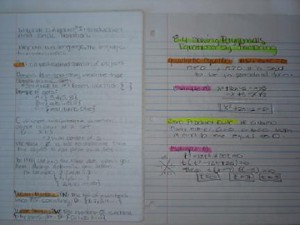Student Outlines: From Question to Evidence
October 14, 2008
From Windows on Learning: Laura Graff, Dustin Culhan, and Felix Marhuenda-Donate, “Outlining Mathematics: Transforming Student Groaning into Student Learning”
I have always thought a large problem in math and science education is reading. Students are never taught how to read technical textbooks. I knew that somewhere along the way I had mastered this skill, but still could not identify precisely what the skill was. I attended [a workshop on reading offered through the Strategic Learning Initiative (WestEd)]….
During the week I learned that I am an “expert reader” in mathematics. This means I have the knowledge and history that allows me to read math. I was taught to participate in meta-cognitive exercises, exercises that forced me to think about my thinking while I read. I became supersaturated with tools and ideas. I was also cynical, for while all the ideas were great, I could not see incorporating them into my already full curriculum.
How would I incorporate the ideas from Reading Apprenticeship without compromising my class and homework time? I decided to assign the outlines to “at risk” students – those with scores below 75 percent.
I was at first amazed that the idea of outlines was considered innovative. However, as we used inquiry and analyzed student outcomes, we were amazed at the positive results. When we videotaped students this summer talking about the effect the outlines had on them, it was one of those huge “paydays,” where you realize you have made a difference in students’ lives and learning.
Adapted from Laura Graff, Dustin Culhan, and Felix Marhuenda-Donate, “Outlining Mathematics: Transforming Student Groaning into Student Learning”
Developing Questions, Student Interviews, Video Evidence Comments Off

